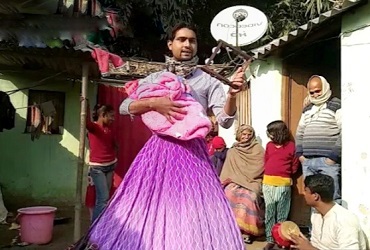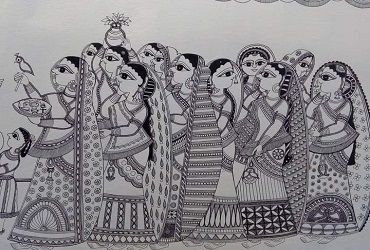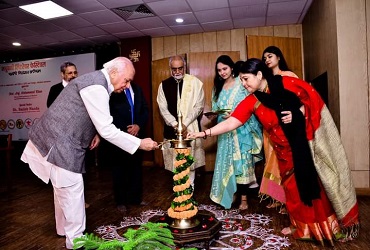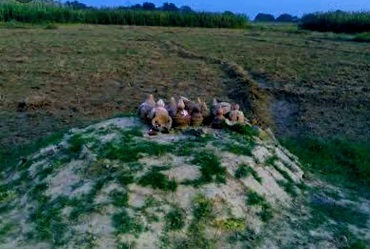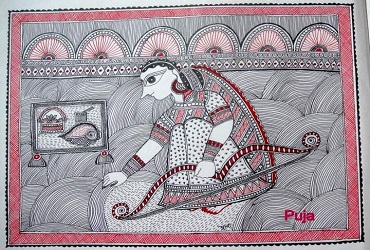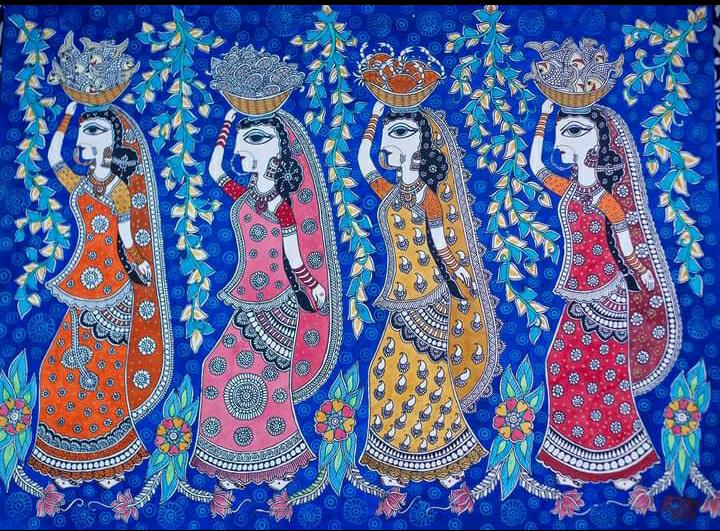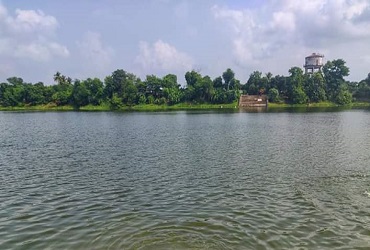This paper is an attempt to locate the region Mithila through the Varnaratnakāra, a text of curious subject matter. To begin with, at the request of the Asiatic Society of Bengal and through the authorisation of the Bengal Government, Pandit Haraprasand Sastri conducted a search for Sanskrit manuscripts during the years 1895 to 1900 with the assistance of Pandita Rakhala candra kavyatirtha and Pandita Vinoda-Vihari Kavyatirtha.
It was Pandita Vinoda-Vihari Kavyatirtha who discovered the Varnaratnakāra of Jyotirīsvara -Kavisekharacraya during his travel to all over Bengal (including Bihar, Chota Nagpur and Orissa). Thus it was Pandit haraprasad Sastri who brought the text to the academic platform. It is the oldest prose work of Maithili language (North Bihar) preserved in a unique MS. On palm leaf now in the library of the Royal Asiatic Society of Bengal, in its Government Collection of MSS (48/34).
Suniti Kumar Chatterjee and Babua Misra edited the text and was first published in 1940 printed by the Royal Asiatic Society of Bengal. Suniti Kumar Chatterjee in the introduction to the texts attests to the its Maithili origin and Maithili characters and also the fact that no other Bengali or Maithili manuscript of that age (14th century) has yet been discovered.
Written in 1324 CE by the Maithili scholar, priest and poet Jyotirīsvara Thākkura, It is in a nature of a compendium but it is descriptive and contains graphic and detailed sketches of many important aspects of the social economic life of its time.
The subject matter of the text in the words of Pandit Haraprasad Sastri is:
The subject matter of the book is very curious. It gives the poetic conventions. It is a sort of vernacular and Sanskrit terms, a repository of literary similes and conventions dealing with the various things in the world and ideas, which are usually treated, in poetry. We have in it either bare list of terms, or the similes and conventions are set in the framework of a number of ‘descriptions1.
The text is divided into seven or apparently eight chapters called the kallolas. The work is in prose.
The chapters are suitably called Kallolas’ (streams or waves) as the work is a Ratnakāra, i.e., Sea.
In each kallola, there are a number of these lists of terms and conventional similes; each of these lists, or descriptions, is preceded by the formula- atha Varnana. Each kallola has at its end its name, together with the name of the author and the title of the work.
The Kallolas are as follows:
- Nagara Varnana (description of the city)
- Nāyika Varnana (description of the Hero)
- Asthān Varnana (description of royal court)
- Rītu Varnana (description of seasons)
- Prayānak Varnana (various subjects including war, conquest and troops etc)
- Bhāttādi Varnana (desciption of court bards)
- Saṁsāna Varnana (description of the cemetery)
- The title of this kallola (eighth) is missing
The text contains the descriptions of the city; the author has described jewels, clothes, fine expensive stuffs, tents, gambling houses, doctors, astrologers indicating the beautiful city life prevalent in Mithila.
In the Asthān varnana, he has described the beauty and grandeur of the court. In another chapter, kallola he talks about the wars, horses, forests, mountains, cemetery etc. on one hand and the music, dance, poetry on the other thus including everything he witnessed and heard.
Therefore in the words of Suniti Kumar Chatterjee, ‘it is a compendium of life and culture of medieval India in general and of Mithila in particular. the author takes us through the city and gives us a little glimpse into the ugliness that was in a ‘city’
Geographically, the region of Mithila is difficult to locate in the territorial boundaries except on the north, where the Himalayas are immovable. Mithila is a cultural zone that has never remained static.
In the Mithila Mahatmya Khanda of the Brihad Vishnu Purana (5th century CE) , we get an accurate idea of the region. It describes Mithila as situated between the river Ganga and the Himalayas, extending over 15 rivers and from kosi to the Gandaki in the west, for 24 yojanas and from Ganga to the forests of Himalayas for 16 yojanas.
The name Tairabhuktisca mentioned in the list of 26 names of Mithila in the Mithila Mahatmya also indicates its geographical location between the three rivers ganga, gandak and Kosi.
There are many persistent ideas found scattered throughout history and it is largely based on the inferences and the conjectures.
The river Ganga flowing from west to east divides Bihar into two parts, northern and southern. The northern part is constituted by three cultural zones viz, north eastern zone known as Mithila (Maithili speaking area), north west Bhojpuri speaking belt and between the two lies the region of Vajjika speaking people.
Mithila is a cultural-linguistic zone of the eastern part of India. The following districts are generally supposed to constitute the region today: Sitamarhi, Sheohar, Darbhanga, Samastipur, Madhubani, Begusarai, Seharsa, Supaul, Medhepur, Purnia, Katihar, Araria and Khagaria. The southeastern terai of Nepal is also recognized as part of the cultural zone of Mithila.
The Varnaratnakāra also provides a social survey of a city/town of Mithila and its surrounding areas with a clear distinction and spaces.
In recent times, the territory of Raj Darbhanga, one of the richest and largest estates in India of great Zamindari (landlords) coincided very roughly with the region of Mithila in north Bihar, extending into the districts of Monghyr, Bhagalpur and Purnea. The capital of Raj Darbhanga was the city of Darbhanga.
Local historians have noticed a shift to this administrative centre from the sacred centre of the Maithili Brahmins from different places to the core areas of Soitpura or Sotipur (a sacred geography with its heartland being triangle between Darbhanga, Madhubani and Madhepur), where in a group of 36 villages, all the highest ranking Brahmins, i.e. the Shrotriyas have their residences (or trace their original belongings).
The Sahadriya Khanda (a text belonging to the twelfth century) clearly mentions the name of Maithili Brahmins among the five dominant Brahmin communities in north India which indicates of Mithila emerging as an important cultural as well as a linguistic centre. Also Darbhanga, the heartland of Mithila, was also one of the Mahals in the Sarkar of Tirhut during the reign of Akbar, the Mughal ruler.
On the other hand, the Pañjī Prabandha (tradition of recording the genealogies) a unique institution of Maithili Brahmins established the endogamous boundaries of a new Maithili Brahmin community through the restriction on marriages and reproduction. The system is important for the sake of our discussion because it also dictates the future membership in the community, which established its territorial boundaries as well. The frequency of Land Grants to Brahmins during the period preceding the period under consideration indicated the growing popularity of the region (sources indicates the Brahmins migrating to the region of Mithila). The Pancobh Copper Plate inscription is an important example referring to the migration of people (Brahmins) from Kolancha to this region in the 11th century CE. The Bangaon Copper plate inscription also indicates that a Brahmin names Ghāṇṭūkaśarman from Kolancha was given land in north Bihar in the 12th century.
In her study of Brahmin migration in north India, Swati Datta writes that one of the chief causes of migration among Brahmins was political instability in home regions and the desire for security and stability, and improved livelihood. Therefore it is certain that by the 12th century the region Mithila had acquire a distinctive position and an identity of its own.
The texts deals with various topics including the production and commerce, the mechants and traders, the rulers and prostitutes and even the name of many countries seems to have visited the court of Mithila during the fourteenth century.
Jyotirīsvara mentions flattened rice (Churā, Chividyani) and fried rice (farhi). Thus, a fine variety of Churā (parched rice) with a heavy coat of thick curd and cream seems to have been a popular food of Mithila. Other items included Mungwa, Ladivi, Saruāri, Madhukupī, Mātha, Fenā, Tilwā, etc. He took delight in describing these items in feasts of the region
‘dadhi sharataka chandrama purnima pray…chewula uppar dadhidela’.
The use of betal-leaves (Pān) in Mithila was very popular then and now. The people of Mithila were adept in the use of betal leaves and Jyotirīsvara has prescribed a number of methods for the use of betals.
“nayaken pān mukhasuddhi kayela”
“Pan karpurak biniyoga”.
Jyotirīsvara has mentioned thirteen qualities of betel-leaves and has given a list of the varieties of spices and betel-nuts imported from other places.
“muktāk chūna, sindhuka kandakola, sinhal dwipak jātī fal, kanchik mukimen..ekone Sonjoge lagawal panchfal”.
There is a long list of the industries found in the text which includes fisheries, salt, opium liquor, iron, sugar, metal work, paper industry, stone and brisk works and various others such as inlay of stone works and enameling are mentioned. Other items includes alchohol (madira), oil (Sughandha elātel) and shampoo of at least four kinds such as Sõndu, Goñdu, Kiratū and Kānhū
We have an elaborate discussion about the textile and the costumes. It is very interesting to know that in the matter of costumes and dress materials, Jyotirīsvara doesn’t include the dresses worn by the women.
<br.
The textile industry included the manufacture of cotton, woolen and silk cloths in which the Dyeing industry, calico printing industry etc. also were imvolved.
Jyotirīsvara mentions as many as 43 stuffs manufactured in the country (des̃i) or imported in the separate lists named vastra varnana, the desiya varnana, the nirbhusan varnana, the neta varnana etc.
Horses are frequently mentioned. Asvavidya, asvavahaka, asva-ratha, asvaprakara are some of them. Asvaratha is mentioned in the list of the sorodasamahadana-varnana (16 mahadanas, great gifts). The various named of horses are turang ghola and ātāji, also horses of 24 breeds are mentioned.
Along with it the text also contains innumerable references to articles of diferent metals like gold, silver, bell-metal, alloy of eight metals (astạdhātu) etc.
It has been noted that region of Mithila was agriculturally one of the most developed and prosperous regions of eastern India. The other two main sources of wealth were Trade and fishing.
Stephen Henningham in his outstanding work ‘A Great Estate and its Landlords in Colonial India’ has shown the twin city of Darbhanga has been a prominent urban center already when the British rule was established. The main source of Mithila’s wealth (as is true for whole India) was agriculture. The natural fertility of the soil in most parts, copious rainfall and irrigation facilities provided since the early times, combined with industry of their peasants, Rich crops, such as cotton, sugarcane, lintents, oilseeds poppy, indigo etc., were produced in a large scale.
Though agriculture was occupation of the bulk of the people, there were many important industries in the rural as well as the urban areas. The trade and commerce have played a vital role in making Mithila evolve as a major actor in the economic world in ancient and medieval times. The period was marked by substantial commercial activities and urban developments. Literary evidences have shown that trade and commerce was the mainstay of the economy carried out by water and land.
To conclude, the above account of the various subjects described or listed the very great value of the text can be easily seen. It gives the microscopic view as Jyotirīsvara has witnessed the times quite evident in the description. While on one hand the presence of the Turko-Persian-Arabic words and on the other hand the knowledge of mostly Brahmanical works like the Puranas and the Mahabharata as well as the descriptions of the countries and the items exchanged clearly shows that the text cannot be ignored as it proves of the vibrant economy, a part of the composite culture.
Ref:
1.Quoted in Suniti Kumar Chatterjee Introduction
Bibliography:
Chatterji, Suniti Kumar and Babua Miśra Eds. Varṅaratnakāra of Jyotirīsvara-Kaviśekharacārya, edited with English and Maithili introductions. The Royal Asiatic Society of Bengal. 1940.
Choudhary, Radhakrishna, ed. “The Panichobh Copperplate of Samgramagupta (C. 12th-13th Cent. A. D.)” In Select Inscriptions of Bihar, Introduction and Appendix in English and Text in Sanskrit, 113–115. Madhipura: Shanti Devi, 1958.
Datta, Swati. Migrant Brāhmaṇas in Northern India: Their Settlement and General Impact, c. A.D. 475–1030. Delhi: Motilal Banarsidass, 1989.
Henningham, Stephen. A Great Estate and Its Landlords in Colonial India, Darbhanga, 1860–1942. Delhi: Oxford University Press, 1990.
Sircar, Dineschandra. “Bangaon Plate of Vigrahapal III; Regnal Year 17.” Epigraphia Indica XXIX, pt. I (1951): 48–57.

 +91-
+91- csts.ind@gmail.com
csts.ind@gmail.com 


